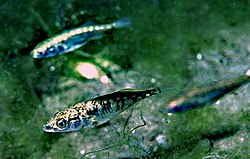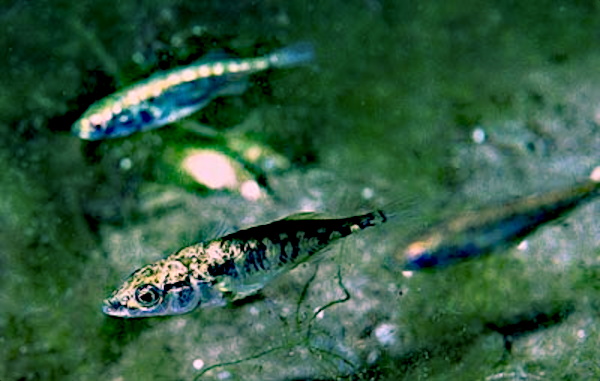| Sticklebacks | |
|---|---|
 |
|
| Three-spined stickleback, Gasterosteus aculeatus | |
| Scientific classification | |
| Kingdom: | Animalia |
| Phylum: | Chordata |
| Class: | Actinopterygii |
| Subclass: | Neopterygii |
| Infraclass: | Teleostei |
| Order: | Gasterosteiformes |
| Family: | Gasterosteidae |
| Genera | |
| Apeltes Culaea Gasterosteus Pungitius Spinachia‘They live in both limnetic zones and Benthic zones’ |
|
The Gasterosteidae are a family of fish including the sticklebacks. FishBase currently recognises sixteen species in the family, grouped in five genera. However several of the species have a number of recognised subspecies, and the taxonomy of the family is thought to be in need of revision. Although some authorities give the common name of the family as “sticklebacks and tube-snouts”, the tube-snouts are currently classified in the related family Aulorhynchidae.
An unusual feature of sticklebacks is that they have no scales, although some species have bony armour plates. They are related to pipefish and seahorses.
Stickleback are most commonly found in the ocean, but can be found in some freshwater lakes. The freshwater species were trapped in freshwater lakes in Europe, Asia and North America after the ice age, and have evolved different features from the ocean variety. They feed on small crustaceans and fish larvae.[1][2]
Sticklebacks are distinguished by the presence of strong and clearly isolated spines in the dorsal fin. Their maximum length is about 4 inches, but few of them are more than 3 inches long. They mature sexually at a length of about 2 inches.[3] All species show a similar mating behaviour, which is also unusual among fish. The males construct a nest from vegetation held together by secretions from their kidneys. The males then attract females to the nest. The female will lay their eggs inside the nest where the male can fertilise them. The male then guards the eggs until they hatch.[2]
http://en.wikipedia.org/wiki/Stickleback






